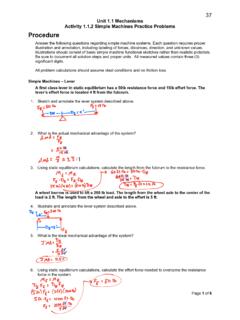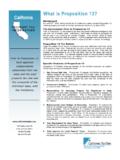Transcription of Three Minute High School Reading Assessment
1 Three Minute High SchoolReading AssessmentAuthors:Timothy RasinskiandNancy Padak 1 Three Minute High School Reading Assessment Authors: Timothy Rasinski and Nancy Padak Directions for Administering the Graded Passages Administering the Graded Passages is simple and straightforward. You simply ask students to read a grade-level passage to you and ask them to recall what they remember from the passage after it has been read. While students read and recall the passage, you monitor their performance for word recognition, fluency, and comprehension. The specific directions are outlined below (in the directions below we identify the student by use of the male pronoun for the sake of convenience only): 1. Present the student with a copy of the passage from Graded Passages that corresponds to his assigned grade level. (We ask students to read a passage at their assigned grade level in order to determine their level of performance on passages that they are expected to master during that grade level.)
2 Ask the student to read the passage orally to you in the way he might normally read the passage. Tell the student that at the end of the Reading you will ask him to tell you what he remembers about the passage. 2. Have the child read the passage aloud for 60 seconds. If the student stops at an unknown word and does not attempt to pronounce it for 2 seconds, or if the student attempts the word but clearly has little chance of Reading it correctly, tell the student the word and ask him to continue Reading . During the oral Reading you should have a copy of the passage in front of you. Mark any uncorrected errors that the student makes by drawing a line through the missed word . Errors include words that are mispronounced or 2 omitted or that you provide to the student. If a child mispronounces or omits a word, but later corrects the word, write and circle a c above the word to indicate it was corrected. At the end of the 60-second period, mark where the student is at in the text.
3 3. After the student has read for 60 seconds, direct his attention to the beginning of the text and ask the student to follow along silently while you read the text aloud to him. Read the passage to the child in a normal and expressive voice. (You read the text to the student to remove any difficulties the student may have in word recognition or fluency that may hamper his comprehension of the passage. Listening comprehension is a good measure of the students Reading comprehension). At the end of your Reading , remove the passage from view of the student and ask him to tell you what he remembers from the passage. After the student has retold the passage, ask him if he has anything else he remembers about the passage. If the student is unable or unwilling to retell anything from the passage, you may ask the student for specific information ( , What is the main idea of this story? What was described in this story?)
4 Especially if the student has made few oral Reading errors, you may, as an alternative to Reading the passage to the student, ask him to read the rest of the passage silently. At the end of the student s Reading remove the passage from his view and ask him to retell what he remembers from the Reading . Keep in mind that a source of difficulty in comprehension may be problems in word recognition or fluency. After the student has retold the passage, the Assessment is complete and needs to be scored. 3 Scoring and Interpreting the Graded Passages Scoring the Graded Passages is simple and quick. The following procedures should be followed: Word Recognition (Decoding). Word recognition is determined by calculating the percentage of words read correctly in the 60-second oral Reading . Divide the total number of words read (correct and incorrect) by the total number of words read correctly. For example, if the student read a total of 94 words in the 60- second read and made 8 errors, the percentage of words read correctly would be reflected in the following fraction: 86 (86 divided by 94) = 94 In other words, the student read of the words correctly.
5 Instructional Reading level is normally marked by a word recognition accuracy rate of 92-98%. Independent Reading level is normally marked by an accuracy rate of 99-100%. A normally developing student should begin a grade Reading material at that grade level at an instructional level and, by the end of the School year, at an independent word recognition level. For example, a ninth grader s performance on a ninth-grade passage would be instructional at the beginning of the year but independent by the end of the year. Students who perform at the frustration level at the end of the School year, or who do not demonstrate good progress over the year, should be considered for additional Assessment to confirm their decoding 4 difficulty. Such students may benefit from specific instructional intervention in decoding. Reading Fluency-Automaticity. One way Reading fluency can be measured is through Reading rate. Reading rate provides a measure of the extent to which a reader can automatically decode words, thus leaving cognitive resources free for the more important task of comprehending a passage.
6 To determine rate, simply count the number of words the student has read correctly during the 60-second oral read. (Words read correctly include those words that were initially errored but then later corrected by the student.) Then compare the students performance against the Reading rates shown below for the appropriate grade and time within the year. Target Reading Rates by Grade Level Grade Fall Winter Spring 9- 10 120-170 wcpm 130-180 140-190 10-11 130-180 140-190 150-200 Students whose Reading rate falls within the appropriate range shown above are performing at grade level expectations. Students who fall below the range may be considered at risk in terms of fluency-automaticity. Students whose Reading rate is above the range limits may be considered to be doing well in fluency-auomaticity; however, students who read exceptionally fast without attending to punctuation and other phrase boundaries, and who read without sufficient expression may also be considered at risk in fluency.
7 Additional 5 Assessment may be appropriate for students who perform poorly at the end of the year or who do not show improvement over the course of the School year. Students considered at-risk in fluency may benefit from instruction aimed at improving Reading fluency. Reading Fluency-Expression. Reading fluency is more than just Reading fast. It is also the ability to interpret a text with appropriate phrasing and expression. You can measure this dimension of fluency by listening to the student s 60-second oral read and rating it on the Multidimensional Fluency Scale below. Initially you may need to tape record the student s Reading and listen to it in order to provide a rating for each of the four scales. Soon, however, you will be able to score the scales on the spot. At the beginning of the School year it is not unusual for students to score in the bottom half of each of the fluency dimensions ( , to have a total fluency score of 8 or below).
8 However, by the end of the School year, students should be rated in the top half in each dimension when Reading grade-level material ( , to have a total fluency score of 9 or above). End-of-year ratings in the bottom half for any of the fluency dimensions, or a total fluency score of 8 or less, may indicate a need for additional Assessment or instructional intervention. 6 Multidimensional Fluency Scale* Score Expression & Volume Phrasing Smoothness Pace 1 Reads words as if simply to get them out. Little sense of trying to make text sound like natural language. Tends to read in a quiet voice Reads in monotone with little sense of phrase boundaries; frequently reads word-by-word. Makes frequent extended pauses, hesitations, false starts, sound-outs, repetitions, and/or multiple attempts. Reads slowly and laboriously. 2 Begins to use voice to make text sound like natural language in some areas but not in others. Focus remains largely on pronouncing the words.
9 Still reads in a quiet voice. Frequently reads in two- and Three -word phrases, giving the impression of choppy Reading ; improper stress and intonation fail to mark ends of sentences and clauses. Experiences several "rough spots" in text where extended pauses or hesitations are more frequent and disruptive. Reads moderately slowly. 3 Makes text sound like natural language throughout the better part of the passage. Occasionally slips into expressionless Reading . Voice volume is generally appropriate throughout the text. Reads with a mixture of run-ons, mid-sentence pauses for breath, and some choppiness; reasonable stress and intonation Occasionally breaks smooth rhythm because of difficulties with specific words and/or structures. Reads with an uneven mixture of fast and slow pace. 4 Reads with good expression and enthusiasm throughout the text. Varies expression and volume to match his or her interpretation of the passage.
10 Generally reads with good phrasing, mostly in clause and sentence units, with adequate attention to expression. Generally reads smoothly with some breaks, but resolves word and structure difficulties quickly, usually through self-correction. Consistently reads at conversational pace; appropriate rate throughout Reading . This scale is an adaptation of one developed by Zutell & Rasinski, 1991. 7 The multidimensional fluency scale is also useful for helping students evaluate their own Reading and in developing their own understanding of fluency in Reading . Comprehension. How well a student understands what he reads is the ultimate hallmark of proficient Reading . You can get a good sense of the student s ability to understand a text by through the retelling. After the student has completed the 60 second oral read and after you have read the entire passage to the student, remove the passage from the view of the student and ask him to retell to you what he remembers from the passage.





